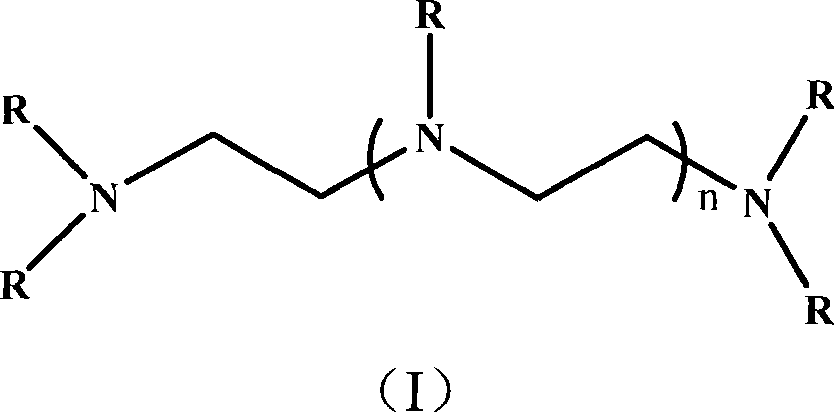Nitrogenous polyfunctional acrylic ester monomer, preparation and use thereof
A multi-functionality, acrylate technology, applied in the preparation of cyanide reaction, chemical instruments and methods, preparation of organic compounds, etc., can solve the problems of isocyanates with irritating odor, skin irritation, and many hydrogen bonds, and achieve product Easy separation and purification, high photopolymerization activity, and mild reaction conditions
- Summary
- Abstract
- Description
- Claims
- Application Information
AI Technical Summary
Problems solved by technology
Method used
Image
Examples
Embodiment 1
[0032] (1) Dissolve 46.45g (0.4mol) of hydroxyethyl acrylate in 50ml of methanol, and add 6.01g (0.1mol) of ethylenediamine dropwise at -10°C. After the dropwise addition, continue to stir for 2 hours, then raise the temperature to 20°C and continue to stir at a constant temperature until the infrared detection 1640 and 810cm -1 The left and right double bond absorption peaks disappeared, the reaction was stopped, and the solvent methanol was removed to obtain 49.85 g of N, N, N', N'-tetrahydroxyethylcarboxyethyl-ethane-1,2 diamine;
[0033] (2) Add 34ml of acryloyl chloride dropwise to 200ml of dichloromethane solution containing 49.85g of N,N,N',N'-tetrahydroxyethylcarboxyethyl-ethane-1,2 diamine and 80g of triethylamine In , the reaction was carried out in an ice bath at 0-5° C. After 4 hours of reaction, the stirring was stopped and left standing overnight. After standing overnight, the reaction was terminated, washed with water, 1M hydrochloric acid, and 1M NaOH solution...
Embodiment 2
[0040] (1) 58.06g (0.5mol) of hydroxyethyl acrylate was dissolved in 50ml of methanol, and 10.32g (0.1mol) of diethylenetriamine was added dropwise at 0°C. After the dropwise addition, continue to stir for 2 hours, then raise the temperature to 25°C and continue to stir at a constant temperature until the infrared detection 1640 and 810cm -1 The left and right double bond absorption peaks disappeared, the reaction was stopped, and the solvent methanol was removed to obtain 64.97g N 1 , N 1 , N2 , N 3 , N 3 - Pentahydroxyethylcarboxyethyl-diethylenetriamine;
[0041] (2) Add 43ml of acryloyl chloride dropwise to the 1 , N 1 , N 2 , N 3 , N 3 -Pentahydroxyethylcarboxyethyl-diethylenetriamine 64.97g and tripropylamine 110g in ethyl acetate 300ml solution, react in an ice bath at 0-5°C, after reacting for 4 hours, stop stirring and let stand overnight. After standing overnight, the reaction was terminated, washed with water, 1M hydrochloric acid, and 1M NaOH solution succ...
Embodiment 3
[0048] (1) 81.28g (0.7mol) of hydroxyethyl acrylate was dissolved in 50ml of methanol, and 18.93g (0.1mol) of tetraethylenepentamine was added dropwise at 10°C. After the dropwise addition, continue to stir for 2 hours, then raise the temperature to 50°C and continue to stir at a constant temperature until the infrared detection 1640 and 810cm -1 The left and right double bond absorption peaks disappeared, the reaction was stopped, and the solvent methanol was removed to obtain 95.20g N 1 , N 1 , N 2 , N 3 , N 4 , N 5 , N 5 - Heptahydroxyethylcarboxyethyl-tetraethylenepentamine;
[0049] (2) Add 60ml of acryloyl chloride dropwise to the 1 , N 1 , N 2 , N 3 , N 4 , N 5 , N 5 -Heptahydroxyethyl carboxyethyl-tetraethylenepentamine 95.20g and tri-n-butylamine 175g in n-hexane 500ml solution, react in an ice bath at 0-5°C, after reacting for 4 hours, stop stirring and let stand overnight. After standing overnight, the reaction was terminated, washed with water, 1M hy...
PUM
 Login to View More
Login to View More Abstract
Description
Claims
Application Information
 Login to View More
Login to View More - R&D
- Intellectual Property
- Life Sciences
- Materials
- Tech Scout
- Unparalleled Data Quality
- Higher Quality Content
- 60% Fewer Hallucinations
Browse by: Latest US Patents, China's latest patents, Technical Efficacy Thesaurus, Application Domain, Technology Topic, Popular Technical Reports.
© 2025 PatSnap. All rights reserved.Legal|Privacy policy|Modern Slavery Act Transparency Statement|Sitemap|About US| Contact US: help@patsnap.com



